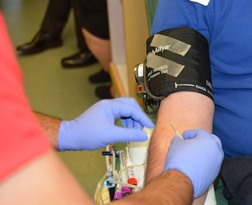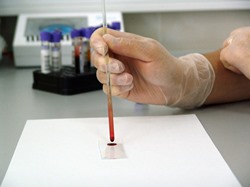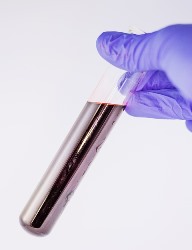Choosing a Phlebotomy Technician School
 Enrolling in the right phlebotomy training is an important first step towards a rewarding career as a phlebotomist. It may seem like a difficult task to analyze and compare all of the school options that are available to you. But it’s important that you do your due diligence to ensure that you receive a quality education. In fact, many students start the process by looking at two of the qualifiers that first come to mind, which are cost and location. Another option that you may consider is whether to attend classes online or commute to a local campus. We’ll talk more about online classes later in this article. What’s important to keep in mind is that there is much more to comparing phlebotomy schools than finding the cheapest or the closest one. Other factors such as accreditation and reputation are also important considerations and should be part of your decision process as well. Toward that end, we will provide a list of questions that you should ask each school you are evaluating to help you choose the right one for you. But before we do that, let’s cover what a phlebotomist is and does, and then continue our discussion about online classes.
Enrolling in the right phlebotomy training is an important first step towards a rewarding career as a phlebotomist. It may seem like a difficult task to analyze and compare all of the school options that are available to you. But it’s important that you do your due diligence to ensure that you receive a quality education. In fact, many students start the process by looking at two of the qualifiers that first come to mind, which are cost and location. Another option that you may consider is whether to attend classes online or commute to a local campus. We’ll talk more about online classes later in this article. What’s important to keep in mind is that there is much more to comparing phlebotomy schools than finding the cheapest or the closest one. Other factors such as accreditation and reputation are also important considerations and should be part of your decision process as well. Toward that end, we will provide a list of questions that you should ask each school you are evaluating to help you choose the right one for you. But before we do that, let’s cover what a phlebotomist is and does, and then continue our discussion about online classes.
[campusexplorer header_text=”Find Phlebotomy Schools Near You!” aos=”75346615″ concentration=”E7147EE5″ tracking=”PHL-CT”]
Phlebotomist Job Description
 A phlebotomist, or phlebotomy technician, draws blood from patients. Although that is their main function, there is actually much more to their job description. Prior to collecting a blood sample, a phlebotomist must confirm that the instruments being used are single use only and sterile. After collection, the sample must be correctly labeled with the patient’s information. Next, paperwork must be properly completed in order to track it from the point of collection through the lab screening process. The phlebotomist then transports the blood to either an in-house lab or to an outside lab facility where it can be screened for such things as infectious diseases, pregnancy or blood type. Some phlebotomists actually work in labs and are responsible for making sure that samples are analyzed properly under the strictest quality control procedures. And if that wasn’t enough, they may be called upon to train other phlebotomists in the collection, delivery and follow-up process.
A phlebotomist, or phlebotomy technician, draws blood from patients. Although that is their main function, there is actually much more to their job description. Prior to collecting a blood sample, a phlebotomist must confirm that the instruments being used are single use only and sterile. After collection, the sample must be correctly labeled with the patient’s information. Next, paperwork must be properly completed in order to track it from the point of collection through the lab screening process. The phlebotomist then transports the blood to either an in-house lab or to an outside lab facility where it can be screened for such things as infectious diseases, pregnancy or blood type. Some phlebotomists actually work in labs and are responsible for making sure that samples are analyzed properly under the strictest quality control procedures. And if that wasn’t enough, they may be called upon to train other phlebotomists in the collection, delivery and follow-up process.
Where do Phlebotomists Work?
The simplest answer is wherever there are patients. Their workplaces are numerous and diverse, such as hospitals, medical clinics, long-term care facilities, or blood banks. They may be tasked to collect blood samples from patients of all ages, from babies or young children to seniors. Some phlebotomists, based on their training and their practice, specialize in drawing blood from a specific type of patient. For example, those working in a nursing home or assisted living facility would only be drawing blood from elderly patients. If they are working in a maternity ward, they would be drawing blood from newborns and mothers exclusively. In contrast, phlebotomists working in a general hospital environment would be collecting samples from wide range of patients and would work with new patients on a daily basis.
Phlebotomy Training, Certification and Licensing
 There are basically two types of programs that provide phlebotomy training, which are certificate and degree programs. The certificate program usually takes under a year to complete and provides a basic education as well as the training on how to draw blood. It provides the fastest method to becoming a phlebotomist. An Associate of Science Degree in Clinical Laboratory Science, although not specifically a phlebotomy degree, will include training to become a phlebotomist. Offered in community colleges, they typically take 2 years to complete. Bachelor’s Degrees are less available and as a 4 year program provide a more comprehensive background in lab sciences. Once you have completed your training, you will want to become certified. Although not required in most states, most employers require certification before hiring technicians. Some of the primary certifying organizations include:
There are basically two types of programs that provide phlebotomy training, which are certificate and degree programs. The certificate program usually takes under a year to complete and provides a basic education as well as the training on how to draw blood. It provides the fastest method to becoming a phlebotomist. An Associate of Science Degree in Clinical Laboratory Science, although not specifically a phlebotomy degree, will include training to become a phlebotomist. Offered in community colleges, they typically take 2 years to complete. Bachelor’s Degrees are less available and as a 4 year program provide a more comprehensive background in lab sciences. Once you have completed your training, you will want to become certified. Although not required in most states, most employers require certification before hiring technicians. Some of the primary certifying organizations include:
- National Phlebotomy Association
- National Healthcareer Association (NHA)
- American Society for Clinical Pathology (ASCP)
- American Medical Technologists (AMT)
There are some states that do require certification in order to practice as a phlebotomist, such as Nevada and California. California and a few other states even require licensing. So it’s important that you choose a phlebotomy training program that not only provides a quality education, but also prepares you for any certification or licensing exams that you elect or are required to take.
Online Phlebotomy Classes
 First, let’s dispel one possible misconception. You can’t receive all of your phlebotomy training online. A good part of the curriculum will be clinical training and it will be conducted either in an on campus lab or in an approved healthcare facility. Many courses also require completion of an internship in order to graduate. But since the non-clinical portion of the training can be accessed online, it may be a more convenient option for some students. As an additional benefit, some online classes are less expensive than their on-campus counterparts. And some expenses, such as for commuting or textbooks, may be reduced as well. Just make sure that the online phlebotomy program you enroll in is accredited by a local or national accrediting organization (more on accreditation later). With both the comprehensive clinical and online training, you can receive a quality education with this method of learning. If you are disciplined enough to learn at home, then earning your certificate or degree online may be the right choice for you.
First, let’s dispel one possible misconception. You can’t receive all of your phlebotomy training online. A good part of the curriculum will be clinical training and it will be conducted either in an on campus lab or in an approved healthcare facility. Many courses also require completion of an internship in order to graduate. But since the non-clinical portion of the training can be accessed online, it may be a more convenient option for some students. As an additional benefit, some online classes are less expensive than their on-campus counterparts. And some expenses, such as for commuting or textbooks, may be reduced as well. Just make sure that the online phlebotomy program you enroll in is accredited by a local or national accrediting organization (more on accreditation later). With both the comprehensive clinical and online training, you can receive a quality education with this method of learning. If you are disciplined enough to learn at home, then earning your certificate or degree online may be the right choice for you.
Phlebotomy School Qualifying Questions
Now that you have a general idea regarding what is involved in becoming a phlebotomist, it’s time to begin your due diligence process. You may have already decided on the type of program you want to enroll in, whether it be for a certificate or a degree. As we mentioned earlier, the location of the school is important as well as the cost of tuition. Perhaps you have decided to enroll in an online phlebotomy school. All of these decisions are an important part of the process of choosing a school or program. But they are not the only considerations when making your decision. Below we have provided some questions that you should ask about each of the schools you are considering before making your final selection.
Is the Phlebotomy Program State Specific? As mentioned previously, each state has its own regulations for practicing as a phlebotomist. Some states require certification, while some others require licensing. Each has its own requirement regarding the minimum amount of clinical training completed before working as a phlebotomist. As a result, you may have to pass a State Board, licensing or certification exam. Therefor it’s very important to enroll in a phlebotomy program that meets the state specific requirements where you will be practicing and prepares you for any exams you may have to take.
Is the Program Accredited? The phlebotomy school and program you enroll in should be accredited by a respected regional or national accrediting organization, such as the National Accrediting Agency for Clinical Laboratory Sciences (NAACLS). There are several benefits to graduating from an accredited program in addition to a guarantee of a quality education. First, if your program is not accredited, you will not be able to take a certification exam administered by any of the previously listed certifying organizations. Next, accreditation will help in obtaining financial aid or loans, which are often not available for non-accredited schools. Finally, graduating from an accredited school can make you more attractive to prospective employers in the job market.
What is the School’s Reputation? In many states there is little or no regulation of phlebotomy schools, so there are those that are not of the highest caliber. So in addition to accreditation, it’s important to check the reputations of any schools you are considering. You can start by asking the schools for references from employers that they refer their students to as part of their job placement program. You can screen online school reviews and rating services and solicit the accrediting organizations for their reviews as well. You can also check with some local clinics or hospitals that you may be interested in working for and ask if they can provide any insights. As a final thought, you can check with the {state} school licensing authority and find out if any complaints have been filed or if the schools are in full compliance.
Is Adequate Training Provided? First, check with the state where you will be practicing to find out if there are any minimum requirements for the length of training, both classroom and practical. As a minimum, any phlebotomy program that you are considering should provide at least 40 hours or classroom training (most require 120) and 120 hours of clinical training. Anything less than these minimums may indicate that the program is not comprehensive enough to provide adequate training.
Is there an Internship Program? Ask the schools you are considering if they have an internship program in partnership with local medical facilities. They are the optimal way to get hands-on practical training typically not available on campus. As an added benefit, internships can assist students establish contacts within the local {city} healthcare community. And they look good on resumes as well.
Is Job Placement Assistance Provided? Finding your first phlebotomy position will be much easier with the help of a job placement program. Find out if the schools you are considering offer assistance and what their job placement rate is. If a school has a high rate, meaning they place most of their students in jobs, it’s an indication that the school has both a good reputation as well as a large network of professional contacts within the medical community.
Are Classes Available as Needed? Finally, it’s important to make sure that the final school you select offers classes at a time that are convenient with your busy schedule. This is especially true if you decide to continue working while going to school. If you need to attend classes in the evenings or on weekends near your residence, make sure they are offered at those times. Also, if you can only attend part-time, make sure it is an option as well. Even if you have decided to study online, with the clinical training requirement, make sure those hours can also be completed within your schedule. And find out what the make-up policy is in case you have to miss any classes due to illness or emergency.
Find the Right Phlebotomy Course
Making sure that you enroll in the right phlebotomy training is an important first step toward your success in this rewarding healthcare career position. As we have covered in this article, there are several factors that go into the selection of a quality school. The most important point is that you need to carefully screen and compare each school before making your final choice. By asking the questions that we have provided, you will be able to narrow down your options so that you can pick the right school. And with the proper education, you can achieve your goal of becoming a phlebotomist.
